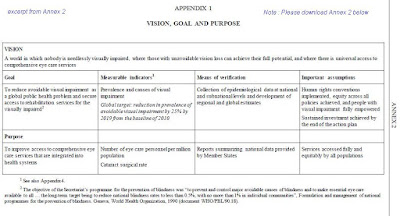Excerpt
The most recent WHO estimates on the global magnitude and causes of visual impairments confirm a major opportunity for change in the lives of millions of people: 80% of all causes of visual impairment are preventable or curable. WHO estimates that in 2010 there were 285 million people visually impaired,
The most recent WHO estimates on the global magnitude and causes of visual impairments confirm a major opportunity for change in the lives of millions of people: 80% of all causes of visual impairment are preventable or curable. WHO estimates that in 2010 there were 285 million people visually impaired,
of which 39 million were blind. If just the two major causes of visual impairment were considered priorities and control measures were implemented consistently across the world, by providing refractive services and offering cataract surgery to the people in need, two thirds of the visually impaired people could recover good sight. This scenario appears to be fairly easy to realize, but for multiple reasons both the aforementioned eye diseases remain major items on the unfinished agenda of public eye care
Dr Oleg Chestnov
Assistant Director-General
Noncommunicable Diseases and Mental Health
World Health Organization
Excerpt
Elimination of avoidable blindness depends on progress in other global health and development agendas, such as the development of comprehensive health systems, human resources for health development, improvements in the area of maternal, child and reproductive health, and the provision of safe drinking-water and basic sanitation. Eye health should be included in broader noncommunicable and communicable disease frameworks, as well as those addressing ageing populations. The proven risk factors for some causes of blindness (e.g. diabetes mellitus, smoking, premature birth, rubella and vitamin A deficiency) need to be continuously addressed through multisectoral interventions.





No comments:
Post a Comment